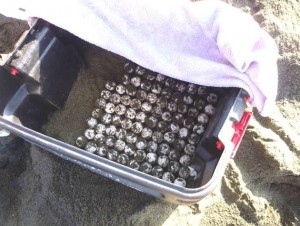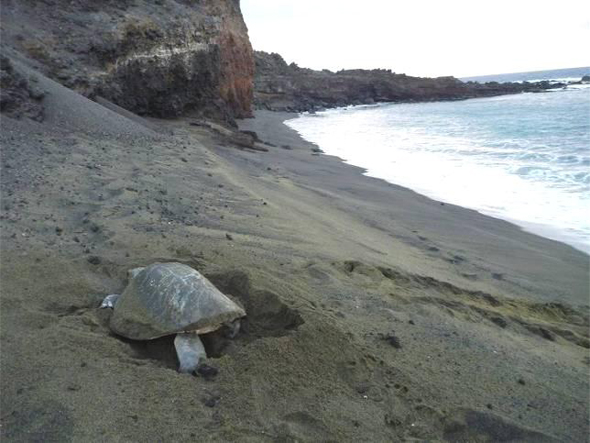 Media release | Hawaii Volcanoes National Park
Media release | Hawaii Volcanoes National Park
At dawn in early November, volunteers of Hawai‘i Volcanoes’ Hawksbill Turtle Recovery Project combed a remote, sandy beach on the Island of Hawai‘i for signs of hawksbill turtles.
They observed a sea turtle laying eggs in the sand of a tidal inundation zone.
However, this small turtle with a heart-shaped shell was neither a hawksbill nor the more common green. This sea turtle was an olive ridley (Lepidochelys olivacea).
Amazingly, the volunteers were witness to an extremely rare sight; this was only the fourth documented olive ridley nesting event in Hawaii.
With the tide rising and surf crashing on shore, the volunteers had to act fast to move the eggs to higher ground before the nest was washed away.
Under supervision of the hawksbill biologist, they excavated the nest and placed the 88 ping-pong ball sized eggs into a container. They then constructed an egg chamber further inland near a patch of morning glory and gently re-buried the eggs in volcanic sand.
While the eggs incubated, volunteers maintained a vigil, protecting the nest from feral cats and mongooses and informing beachgoers of its significance.
Nearly two months later, 76 hatchlings climbed out of the nest and crawled across the sand and into the ocean. Four more emerged over the next few days.
With help from dedicated volunteers, a doomed nest survived. Eighty hatchlings made it safely to the sea for a 90% nest success rate.
Listed under the Endangered Species Act as a threatened species, olive ridleys occasionally stray into Hawaiian waters. More typically, they’re found in the eastern Pacific off Mexico and Central America and are best known for their behavior of synchronized nesting in mass numbers, termed arribadas.
Hawksbill Nesting Season Update
2010 marked the 21st anniversary of the Hawai‘i Island Hawksbill Turtle Recovery Project, a volunteer program started by Hawai‘i Volcanoes National Park.
In mid-January 2011, the final hawksbill nest was excavated marking the end of another long and successful field season. Between April and January, 40 nests from 13 turtles at six different beaches on the southern coastline of Hawai‘i Island were documented and protected. An estimated 4,000 hatchlings reached the ocean with help from more than 40 volunteers who tirelessly monitored the nesting beaches.
The staff and volunteers of the project extend a mahalo nui loa to the Hawai‘i Island community for its continued support of sea turtle conservation efforts.


by Big Island Video News5:22 pm
on at
STORY SUMMARY
Media release | Hawaii Volcanoes National Park At dawn in early November, volunteers of Hawai‘i Volcanoes’ Hawksbill Turtle Recovery Project combed a remote, sandy beach on the Island of Hawai‘i for signs of hawksbill turtles. They observed a sea turtle laying eggs in the sand of a tidal inundation zone. However, this small turtle with […]